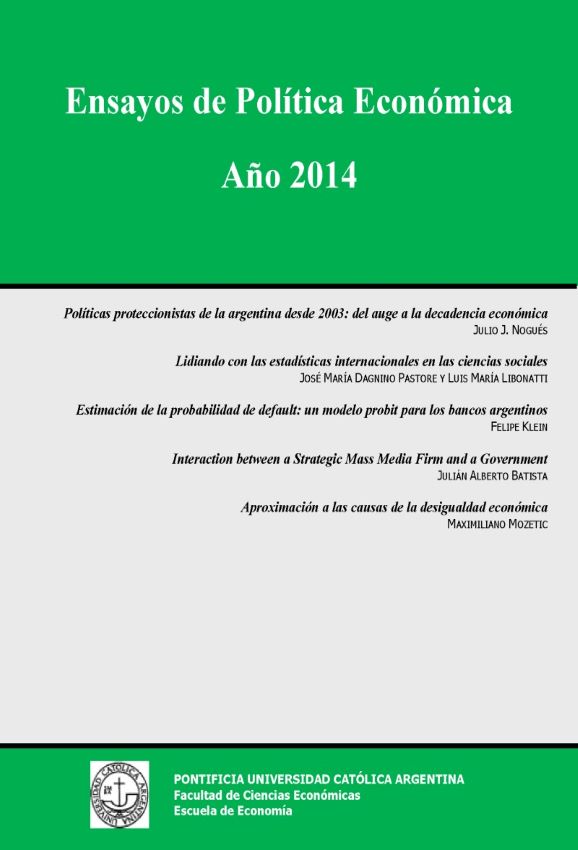Interaction between a strategic mass media firm and a government
Palabras clave:
Medios de comunicación y elecciones, gobierno, votantes, equilibrio de NashResumen
Este artículo intenta teorizar acerca de la dinámica entre los medios masivos de comunicación y los gobiernos de los países latinoamericanos. Si bien en la última década los gobiernos atacaron públicamente a los medios de comunicación, se afirma que no se dio por las razones que dicen, sino más bien por asuntos económicos. Por lo tanto, se ha diseñado un modelo utilizando el método de “principal” vs “incumbente”, donde se alcanzará un equilibrio de Nash perfecto en subjuegos. Además de esto, se realiza un repaso por la literatura conocida, y concluye señalando las fortalezas y debilidades del modelo propuesto.
Descargas
Citas
Baron, D. (2006). Persistent Media Bias. Journal of Public Economics, Vol 90, Issues 1–2, January 2006, pp 1–36.
Besley, T. & Prat, A. (2006): Handcuffs for the Grabbing Hand? The Role of the Media in Political Accountability. American Economic Review, Vol. 96, No. 3, pp 720-736.
Burden, B. (1997): Deterministic and Probabilistic Voting Models. American Journal of Political Science, Vol. 41, No. 4, pp. 1150–1169.
Calvó-Armengol, A., de Martí, J. & Prat, A. (2011). Communication and Influence. Mimeo.
Duggan, J. & Martinelli, C. (2008). Rational Expectations and Media Slant. Mimeo.
Di Tella, R. & Franceschelli, I. (2010). Government Advertising and Media Coverage of Corruption Scandals. Mimeo.
Duggan, J. & Martinelli, C. (2010). A Spatial Theory of Media Slant and Voter Choice. Review of Economic Studies, Vol. 1, 1–29.
Dutta, P. (1999). Strategies and Games: Theory and Practice. Cambridge,
Massachusetts: The MIT Press.
Enelow, J., & Hinich, M. J. (1984): Voting and the Importance of Centrist Ideologies in Democratic Elections, Journal of Politics, Vol. 46, No. 2, May 1984, pp. 459–478.
Fundenberg, D. & Tirole, J. (1991). Game Theory. Cambridge, Massachusetts: The MIT Press.
Feldman, A. M. (1988). Existence of Electoral Equilibria with Probabilistic Voting. Journal of Public Economics, Vol. 35, pp. 205–227.
Gentzkow, M. & Shapiro, J. (2006). Media Bias and Reputation. Journal of Political Economy, Vol. 114, No. 2.
Krause, M., Ravier, A. & Zanotti, G. (2007). Elementos de Economía Política. Buenos Aires: Editorial La Ley.
Krause, M. (2011). Economía, Instituciones y Políticas Públicas. Buenos Aires: Editorial La Ley.
Mas-Colell, A., Whinston, M. & Green (1995). Microeconomic Theory. Oxford University Press.
Mullainathan, S., & Shleifer, A. (2005). The Market for News, American Economic Review, Vol. 95, No. 4 (September), pp. 1031–1053.
Prat, A., & Strömberg, D. (2005): Commercial Television and Voter Information. Discussion Paper No. 4989. Centre for Economic Policy Research.
Prat, A., & Strömberg, D. (2011): The Political Economy of Mass Media. Discussion Paper No. 8246. Centre for Economic Policy Research.
Strömberg, D. (2008): How the Electoral College influences campaigns and policy: the probability of being Florida. American Economic Review, Vol. 98, No 3.
Strömberg, D. (2002a): Mass Media Competition , Political Competition, and Public Policy. Review of Economic Studies, Vol. 71, pp. 265-284.
Strömberg, D. (2001): Mass Media and Public Policy. European Economic Review, Vol 45, No. 4 to 6, May 2001, pp. 652-663.
Sturzenegger, F. & Tommasi, M. (1998). The Political Economy of Reform. The MIT Press.
Watson, J. (2002). Strategy: An Introduction to Game Theory. Second edition. W. W. Norton & Company.
Descargas
Publicado
Cómo citar
Número
Sección
Licencia








